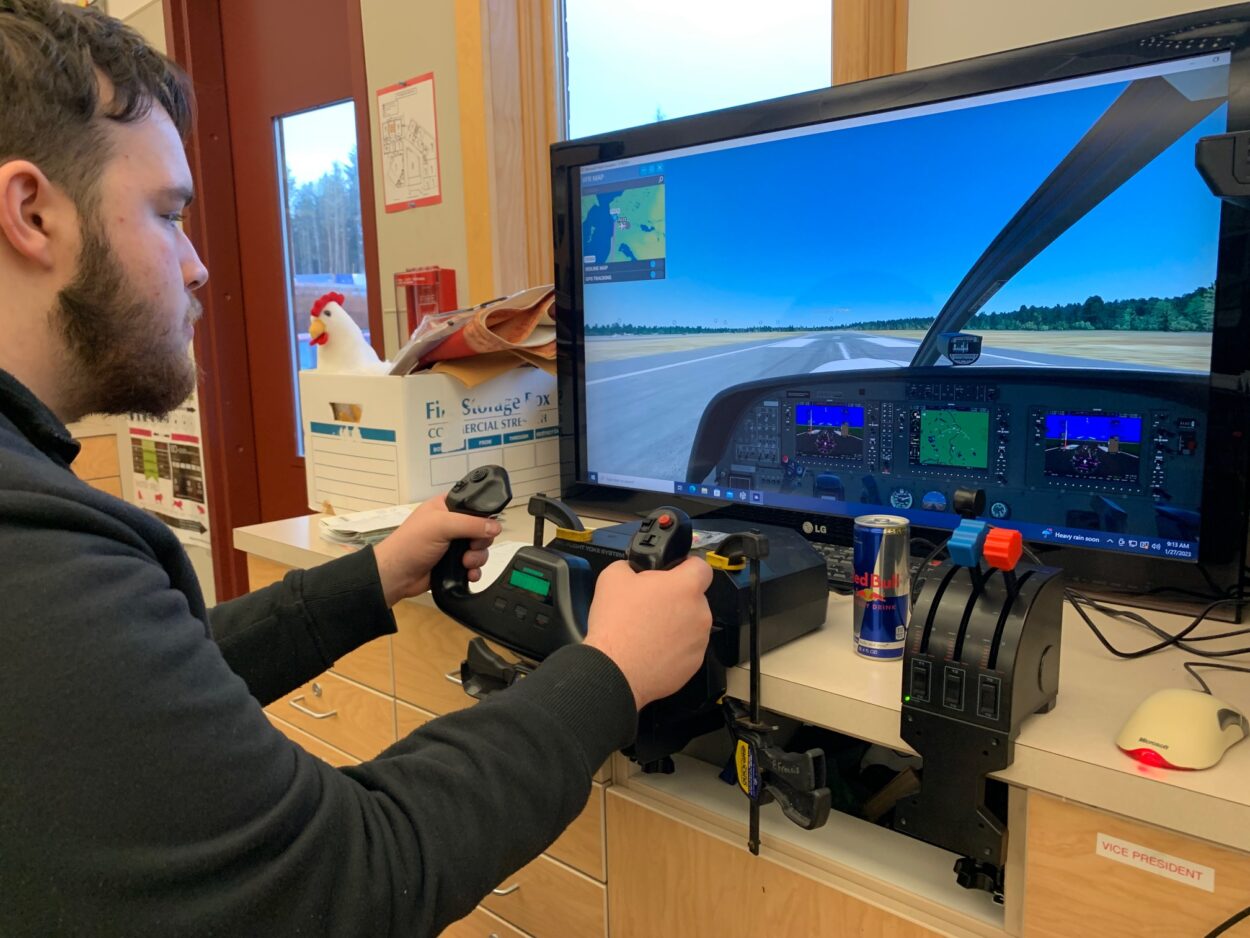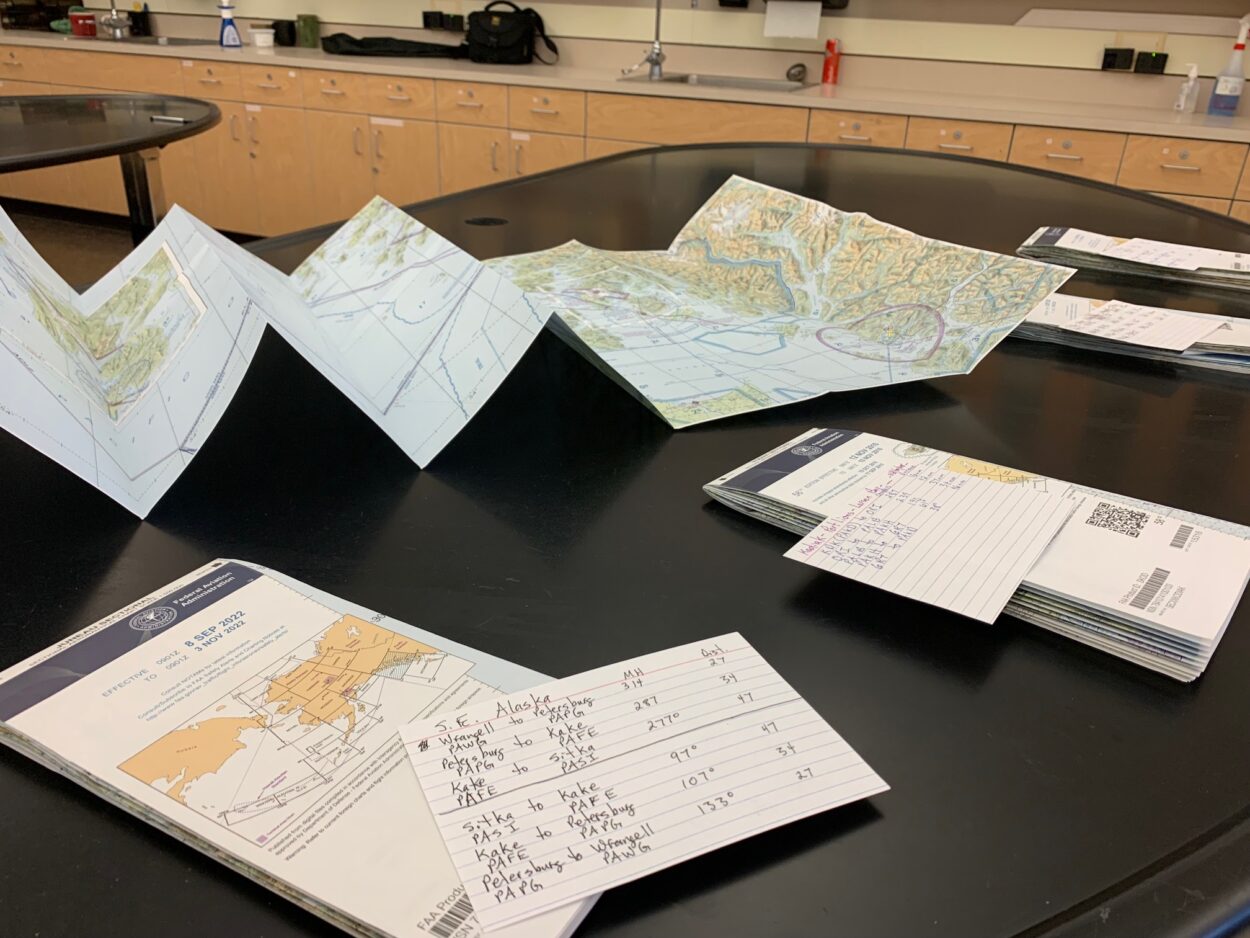
Students at Mt. Edgecumbe High School in Sitka are learning how to fly a plane– before they even set foot in a cockpit. Their aviation ground course is the first step toward becoming a licensed private pilot, and a springboard to the skies.
The the low hum of a single engine airplane reverberates throughout a classroom at Mt. Edgecumbe High School. The sounds of aviation aren’t unusual here — the school looks out on Sitka Sound, and float planes zip by every day.
But the humming is quieter today, because it’s not coming from a real plane. This is a simulation.
Jack Davis teaches the aviation ground-school course at Mt. Edgecumbe. And Fridays are flight simulator day– in the back of Davis’s classroom, three students sit at computers, playing what looks like a video game with a few extra bells and whistles. But it’s not a game– they’re logging flight hours.
“How’s it going Ryder? You’re on track pretty good,” Davis says, looking over the student’s shoulder.
“Okay, I’m gonna let you go for a bit. You guys keep going. I wish I had some inflight peanuts for you,” he adds once all of the students are “in the air” and on the way to their destinations.
Davis got what he calls the “flying bug” when he was teaching in Western Alaska. And once he got his private pilot’s license, he bought a small plane in Texas and flew it home. He’s been teaching in Alaska for 30 years, 15 of them at Mt. Edgecumbe. And for the last five years, he’s taught the aviation ground course.
Throughout the week in his class, students crack the books, building the skills to pass a written test in April. That’s their first step toward earning a private pilot’s license.
“[It’s about] understanding how to communicate with people in the air and who’s there to help you on the radio, and making sure you’re going where you think you’re going,” Davis says of the course. “[And] navigating to the right place and understanding your engine, and making sure it’s not gonna overheat or run out of fuel.”
But on Fridays, they take to the skies, virtually anyway. The simulator is more complicated than your typical video game setup. Students watch their flight progress from a monitor. But instead of using one handheld controller, they have to multitask, managing steering, throttles and pedals to keep their planes gliding above the peaks and valleys of Alaska’s rugged topography.
Davis says the software can simulate flying from nearly every airport in the world. And the class uses paper charts as well.

“I’ve landed on some grass strips in Indiana, on this these simulators. There’s some fun spots,” Davis says, but add that they only have detailed sectional charts for Alaska, and students don’t tend to fly the simulator in the lower 48. He then unfolds a chart to show me how it works.
“We like to fly out where we’re used to,” Davis adds. “And situations in the terrain that they’ll see when they’re in real life.”
Aiden Panzer is a senior from Unalakleet, and today he flew a Cessna Caravan from Kenai, to Homer, then to Soldotna and back. It was a bumpy ride because the simulator incorporates real-time weather conditions. But he tweaked the settings so it would be a little brighter, since this time of year sunlight is scarce up North.
“It kind of keeps you on your toes, which is what you should be doing when you’re actually in the plane. So that’s what I like about this flight simulator specifically,” Panzer says. “It always keeps you on the edge of your seat in case your turbulence knocks you off course.”
For some students, the aviation course is just a fun experience. They dip a toe in and maybe decide they prefer their feet planted firmly on the ground. For others, they get the same “bug” that Davis got. That’s how Panzer feels. He plans to study aerospace engineering next fall in Oregon. After that, he hopes to join the Air Force.
“I’ve always been interested in space, I guess,” Panzer says. “I’m a huge space nerd. So I have a telescope, I look at stars. And I guess that just brings me closer to it…being in an a plane.”
Ultimately, Panzer’s not sure if he wants to fly a jet or a rocket…either way, he says flying helps him feel free.
“Sometimes when I’m walking, and I see a seagull or an eagle, or something like that, I just, like, picture, it would be so awesome to be that bird,” Panzer says. “Go wherever you want.”
If students pass their written test in April, they can move on to the next leg of their flight– getting in the air. Maybe some day, they’ll land their own real float planes in Sitka Sound.






























